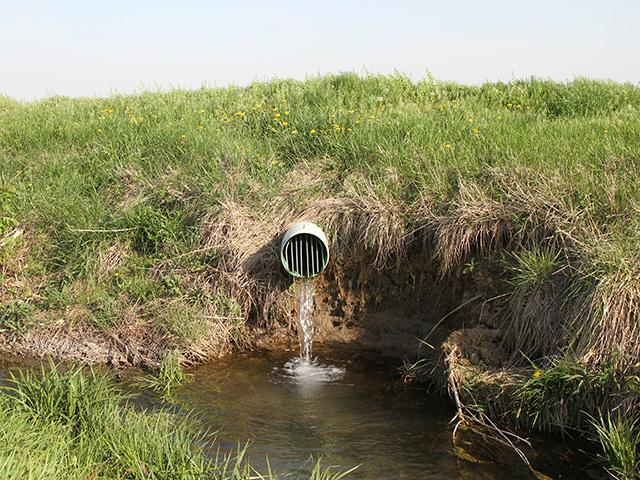States Ahead of Nitrogen Reduction Goal
Nutrient Runoff Reduction Into Mississippi Basin Ahead of Schedule
LINCOLN, Neb. (DTN) -- The massive ongoing effort to reduce nutrient runoff across multiple states in the Mississippi River basin is beginning to pay off, according to a new EPA report to Congress on the work of the Mississippi River/Gulf of Mexico Watershed Nutrient Task Force.
Most notably, the task force said the basin has reduced nutrient runoff by 23% -- exceeding its nutrient reduction goal of 20% by 2025 set by the task force in 2008.
However, the task force said total phosphorous loads have increased into the basin and ultimately to a hypoxic dead zone where low oxygen can kill fish and other marine life. It's caused by excessive nutrient runoff, largely from fertilizer used throughout the Mississippi River basin, which flows south to the Gulf.
The 12 states that are part of the task force include Arkansas, Illinois, Indiana, Iowa, Kentucky, Louisiana, Minnesota, Mississippi, Missouri, Ohio, Tennessee and Wisconsin.
"More work is needed to reduce nitrogen and phosphorus by 48% to meet the Hypoxia Task Force's (HTF) 2035 goal," the task force said in its report.
Agriculture is always a focus of the dead zone because nutrient runoff from more than 30 states feeds into the Mississippi River. States now spend tens of millions of dollars every year on nutrient management strategies to reduce agricultural runoff into tributary streams and rivers.
The American Farm Bureau Federation said in a news release it was pleased with the work done by farmers in the 12 basin states.
"There's still work to be done in the Gulf region and we stand ready to work with our partners at EPA, the U.S. Department of Agriculture and within the task force states to continue the progress we're making," AFBF President Zippy Duvall said in a statement.
P[L1] D[0x0] M[300x250] OOP[F] ADUNIT[] T[]
AFBF said there are economic factors, including planted acreage and associated fertilizer demand, that can influence average nutrient load values within selected time periods.
AFBF said it "encourages continued discussion" on preventing natural sources of phosphorous losses, such as streambank erosion.
"Farmers are problem-solvers by nature, and the work being done in the Mississippi River Basin to reduce nitrogen loads in the Gulf region is proof of what can happen when we come together to find solutions," Duvall said.
"I commend the farmers in each of the HTF states for their instrumental role in making these strides and encourage all stakeholders to continue working together to meet the 2035 goals."
According to the report, basin states continue to expand the amount of load discharge data available to monitor progress on runoff reduction.
Across the 12 states, 86% of facility permits discharging to the basin were required to monitor both nitrogen and phosphorous runoff as of 2020. That's an increase from 70% in 2017, according to EPA.
The report said 41% of facility permits reported limits for nitrogen or phosphorous, also an increase from 32% in 2017.
The 1,232 facilities in the basin contributed 295.8 million pounds of nitrogen and 39.9 million pounds of phosphorus to nutrient loads in the basin. That represents a 2% reduction in nitrogen discharges from those calculated for 2017 and a 5% increase in phosphorous discharges from 2017 levels.
"For context, USGS (Lee 2022) calculates that total MARB (basin) nutrient loads to the Gulf in water year 2020 were approximately 3.7 billion pounds of nitrogen and 452 million pounds of phosphorus," the report said.
"This calculation shows that 8% of all nitrogen loads and 10% of all phosphorus loads discharging to the Gulf were from major sewage treatment facilities, compared to 9% of all nitrogen loads and 14% of all phosphorus loads in 2017."
According to the latest forecast for the so-called "dead zone" in the Gulf of Mexico, the hypoxic zone was expected to be about 4,100 square miles this past summer.
That was about 20% larger than 2022 but still reportedly smaller than average, https://www.dtnpf.com/….
Last year the zone measured about 3,275 square miles -- one of the smaller areas mapped since experts began tracking. The hypoxia area peaked in 2017 at 8,776 square miles.
Read more on DTN:
"Gulf of Mexico Dead Zone Smaller Due to Lower Mississippi River Water Flow," https://www.dtnpf.com/….
Todd Neeley can be reached at todd.neeley@dtn.com
Follow him on X, formerly known as Twitter, @DTNeeley
(c) Copyright 2023 DTN, LLC. All rights reserved.




